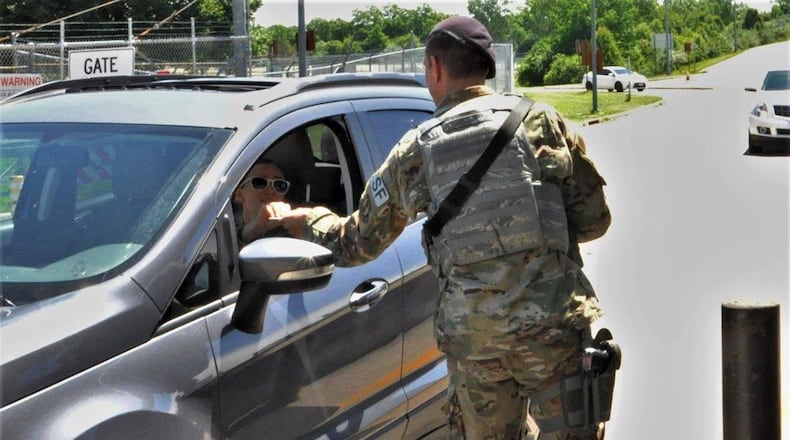But the written and understood duties stemming from that mission reach far beyond checking cards at the gates. Not only do these Airmen also patrol the base, work the flight lines, provide security for base events, train and use military working dogs and ensure sufficient defense over protection-level resources, their work transcends defense altogether.
First line of security means first human contact of the day for many Airmen, a greeting patrons racing the clock to work often overlook. Base personnel arriving through one of seven staffed gates may see entry controllers for half a minute, sometimes waiting begrudgingly in line for longer, but entry controllers assist and monitor patrons for hours – eight hours, in fact, and thousands of ‘have a good day’s per shift. The defenders approach inviting Wright-Patterson’s many law-abiding friends in just as seriously as keeping potential enemies out.
“Being one of the first jobs out here in the morning, you realize people haven’t even talked to anyone yet,” said Meredith, who just months ago was entering Wright-Patt’s gates for the first time himself. “I like interacting with everyone coming through in their cars. It keeps work from becoming static. You get to meet different people and hear their stories.”
“Not all of us are so rough. We’re humans, too,” Smallwood added, applying to military security what his previous occupation in law enforcement called community policing: building trust with the people who visit and live on base as a rule. “Even though I’ve been standing there all day checking ID after ID, I still try to be polite as I can, share a joke with someone, give that good rapport.”
And even knowing best all the crucial protection his Airmen provide, Staff Sgt. Alan Ferry, operations support NCO, thinks first of the way they can encourage patrons in just a few seconds at a car window.
“I’m proud of our entry controllers when I hear people say how professional, friendly and kind our Airman was to them,” said Ferry. “We often hear negative connotations about long waits, but it’s always nice to hear that someone’s day was much better because of a brief interaction with one of our defenders.”
Long shifts and volatile weather are the least of entry controllers’ concerns. In fact, Smallwood enjoys escaping an office and even working in the rain amid the summer heat.
Meredith said that hours outside together encourage camaraderie within the squadron, too.
“This career field creates bonds,” he said. “We change posts every single day. One day I could be on the flight line with one other person for eight hours, and today I’m here with these guys. We get a lot of one-on-one time. We get along very well.”
Instead, it’s navigating scenarios like outdated IDs and card-less cyclers in ways that satisfy the Air Force’s high standards that makes the job challenging.
These incidents, on top of about 30,000 people entering the base each morning, can slow entry down no matter how quick and competent controllers are. Wright-Patterson hosts nearly twice as many civilians as active-duty military personnel, and Smallwood noted that amid all the business casual, guests forget that the base is still a military operation at higher risk.
“We’re doing a 100 percent ID check,” Smallwood said. “Time isn’t necessarily our first concern. It’s security and safety first.”
Prioritizing defense, the SFS recently implemented changes that nonetheless cut traffic time. Visitors may notice that not all gate personnel wear the beret lately. A new initiative called the EAGL (Entry Authorization Gate Liaison) program trains and incorporates military and some civilian personnel into morning entry control duty on a volunteer basis to supplement SFS defenders during rush periods.
Ultimately, it’s the Airmen wearing the berets who uphold lines of security, traffic and relations at the gate and beyond, directly advancing the Air Force’s pledge to fly, fight and win through three channels. Guarding the gates and bending down to eye level on the outside, entry controllers enable engineers to build planes, analysts to deliver briefs, doctors to operate, students to research and pilots to gear up for flight within firm walls.
“We have a more important job for the mission than just standing here at ease,” Meredith said. “We give the ease of mind and protection for everyone else to do their day-to-day jobs.”
Ferry assured visitors and residents that they can trust entry controllers to perform the task well: “With the tools and training our Airmen are provided, the citizens of the base should feel very comfortable when they are at work or home.”
About the Author
